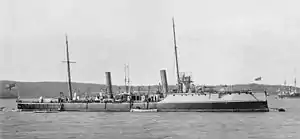HMS Boomerang (1889)
HMS Boomerang was an Sharpshooter-class torpedo gunboat of the Royal Navy, originally named HMS Whiting, built by Armstrong Whitworth, Elswick, Tyne and Wear and launched on 24 July 1889.[3] Renamed Boomerang on 2 April 1890, she formed part of the Auxiliary Squadron of the Australia Station.
 Boomerang anchored at Sydney in c. 1891–1905. | |
| History | |
|---|---|
| Name | Whiting |
| Builder | Armstrong Whitworth, Elswick, Tyne and Wear[1] |
| Yard number | 545 |
| Laid down | 17 August 1888 |
| Launched | 24 July 1889 |
| Completed | 14 February 1891 |
| Renamed | HMS Boomerang – 2 April 1890 |
| Fate | Sold 11 July 1905 at Portsmouth, Hampshire. |
| General characteristics | |
| Type | Torpedo gunboat |
| Displacement | 735 tons |
| Length | 242 ft (74 m) |
| Beam | 27 ft (8.2 m) |
| Draught | 8 ft 6 in (2.59 m) |
| Installed power | 3,600 ihp (2,700 kW) |
| Propulsion |
|
| Speed | 19 kn (35 km/h) |
| Complement | 91 |
| Armament |
|
Service details
Boomerang arrived in Sydney with the squadron on 5 September 1891. Lieutenant and commander Edward Matthew Hale was appointed in command on 15 February 1900.[4]
She left the Australia Station on 22 August 1904. She was sold for £1,900 in July 1905 at Portsmouth.[3]
Notes
- "HMS Boomerang (1891)". tynebuiltships.co.uk. Retrieved 5 April 2017.
- Winfield (2004) p.305
- Bastock 1988, p.105.
- "Naval & Military intelligence". The Times. No. 36052. London. 30 January 1900. p. 11.
References
Wikimedia Commons has media related to HMS Boomerang (ship, 1889).
- Bastock, John (1988), Ships on the Australia Station, Child & Associates Publishing Pty Ltd; Frenchs Forest, Australia. ISBN 0-86777-348-0
- Brown, Les (2023). Royal Navy Torpedo Vessels. Barnsley, UK: Seaforth Publishing. ISBN 978-1-3990-2285-9.
- Winfield, R.; Lyon, D. (2004). The Sail and Steam Navy List: All the Ships of the Royal Navy 1815–1889. London: Chatham Publishing. ISBN 978-1-86176-032-6. OCLC 52620555.
This article is issued from Wikipedia. The text is licensed under Creative Commons - Attribution - Sharealike. Additional terms may apply for the media files.